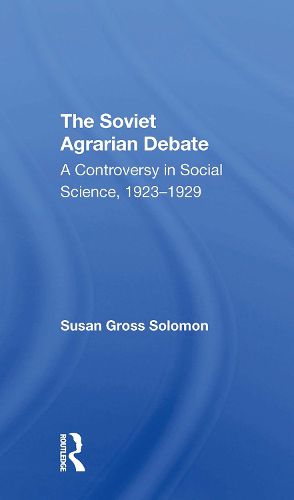Readings Newsletter
Become a Readings Member to make your shopping experience even easier.
Sign in or sign up for free!
You’re not far away from qualifying for FREE standard shipping within Australia
You’ve qualified for FREE standard shipping within Australia
The cart is loading…






The first decade of Soviet cultural life was marked by a pluralism unmatched in the subsequent history of the USSR. In many fields of art and science, Party and non-Party "proletarian" and "bourgeois" intellectuals worked side by side, vigorously debating questions of substance and method. In this first major study of a Soviet field of social science in the post-Revolution period, Dr. Solomon examines the controversy that divided social scientists studying the economy and society of the Soviet peasant during the 1920s. The intellectual disagreements in post-Revolution Soviet rural studies were exacerbated by social, political, and professional differences among the contending scholars. The infighting between the groups was bitter. Yet in contrast to recent studies of other Soviet professions in the 1920s, the author finds that in rural studies Marxists and non-Marxists had much in common. Her findings suggest that the coexistence of the "old" and the "new" in Soviet rural studies might have lasted for some time had not external political forces intervened in late 1928, acting as a pressure on the field and eventually causing its demise.
$9.00 standard shipping within Australia
FREE standard shipping within Australia for orders over $100.00
Express & International shipping calculated at checkout
The first decade of Soviet cultural life was marked by a pluralism unmatched in the subsequent history of the USSR. In many fields of art and science, Party and non-Party "proletarian" and "bourgeois" intellectuals worked side by side, vigorously debating questions of substance and method. In this first major study of a Soviet field of social science in the post-Revolution period, Dr. Solomon examines the controversy that divided social scientists studying the economy and society of the Soviet peasant during the 1920s. The intellectual disagreements in post-Revolution Soviet rural studies were exacerbated by social, political, and professional differences among the contending scholars. The infighting between the groups was bitter. Yet in contrast to recent studies of other Soviet professions in the 1920s, the author finds that in rural studies Marxists and non-Marxists had much in common. Her findings suggest that the coexistence of the "old" and the "new" in Soviet rural studies might have lasted for some time had not external political forces intervened in late 1928, acting as a pressure on the field and eventually causing its demise.